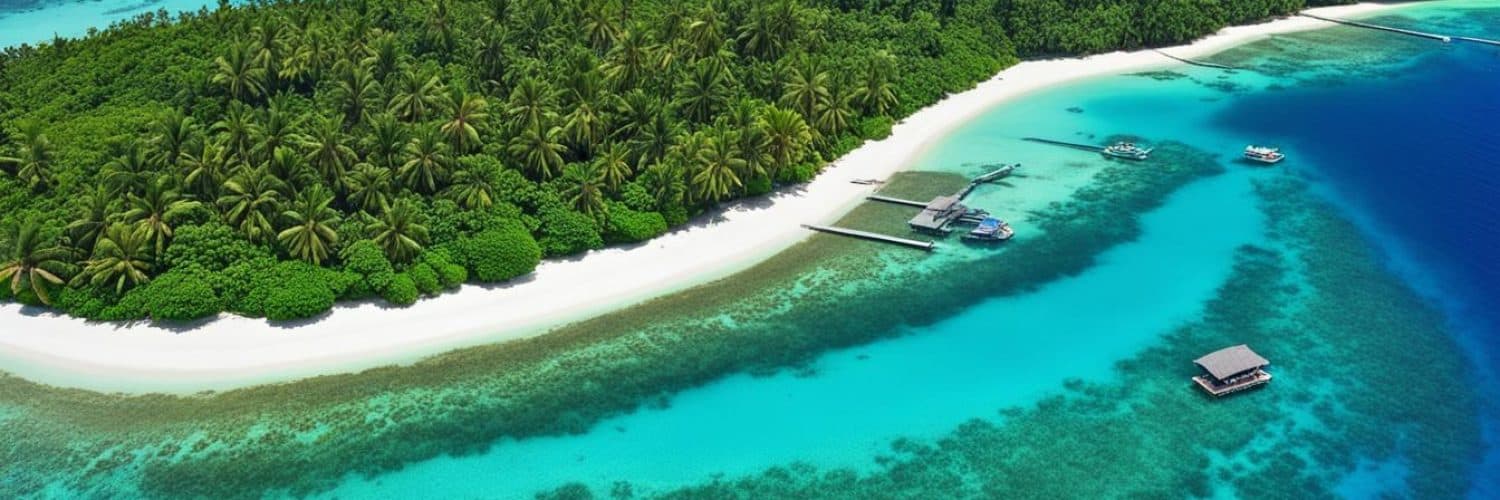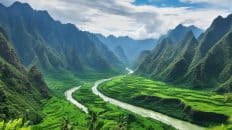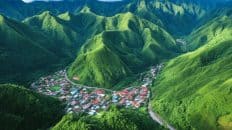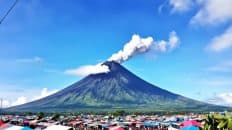Welcome to Mapun, a hidden gem in the Philippines that offers an authentic and off-the-beaten-path travel experience. Nestled in the Tawi-Tawi province, Mapun is known for its serene beaches, rich cultural heritage, and stunning natural beauty. Whether you’re seeking relaxation on pristine white sand beaches or a deep dive into local culture, Mapun has something for everyone.
Mapun, also known as Mapun Island, is a secluded municipality consisting of a main island and several islets. Its diverse topography features hills, valleys, small plains, marshes, and, of course, breathtaking beaches. The name “Mapun” translates to “you forgive” in the native language of the Jama Mapun people, who are the indigenous inhabitants of the area.
Key Takeaways
- Mapun is a secluded municipality located in the Tawi-Tawi province in the Philippines.
- It offers serene beaches, diverse topography, and a rich cultural heritage.
- The name “Mapun” means “you forgive” in the language of the indigenous Jama Mapun people.
- Mapun is easier to reach from Sabah, Malaysia, than from Zamboanga City in the Philippines.
- Join us on a journey to discover the hidden charm of Mapun in the Philippines.
Location and Geography of Mapun
Mapun is a captivating municipality located in the extreme northwest part of the Tawi-Tawi province in the Philippines. Situated 262 kilometers away from the capital city of Bongao and 354 kilometers west of Zamboanga City, it offers a remote and idyllic escape for travelers seeking tranquility.
Spanning a total land area of 28,129 hectares or 281.29 square kilometers, Mapun encompasses a main island and 17 picturesque islets. Its geography is remarkably diverse, characterized by majestic mountains, rolling hills, lush valleys, small plains, enchanting marshes, and pristine white sand beaches. The main island, of volcanic origin, boasts several freshwater crater lakes, adding to the region’s natural charm.
With its breathtaking landscapes, Mapun Island captivates visitors with its remarkable beauty and unique geographical features.
Exploring the Topography of Mapun:
- Mountainous regions
- Rolling hills
- Lush valleys
- Small plains
- Enchanting marshes
- Pristine white sand beaches
- Freshwater crater lakes
Mapun offers a variety of landscapes to explore, each with its own distinct allure. Whether you’re looking to hike through majestic mountains, bask in the serenity of lush valleys, or relax on stunning white sand beaches, Mapun has it all.
Population of Mapun
In 2010, the total population of Mapun was 24,168. However, this does not account for the population variable arising from the periodic migration of the Jama Mapun people to and from Sabah, Malaysia, for seasonal economic opportunities. It is estimated that there are about 15,000 Jama Mapun living in Malaysia, and around 10,000 residing in the southern towns of Palawan such as Bugsuk and Balabac. A small population of the Jama Mapun also live in Zamboanga City and Manila. The total population in the Philippines was estimated to be around 43,000 in 2011.
Table: Population Statistics
| Year | Population of Mapun | Population of Jama Mapun in Malaysia | Population of Jama Mapun in Palawan | Population of Jama Mapun in Zamboanga City and Manila |
|---|---|---|---|---|
| 2010 | 24,168 | – | – | – |
| 2011 | – | 15,000 | 10,000 | – |
“The population of Mapun is a dynamic and diverse mix of residents. The periodic migration of the Jama Mapun people to Sabah, Malaysia, for economic opportunities contributes to the fluctuation in population numbers. Additionally, a significant number of Jama Mapun reside in various parts of Palawan and some even venture to Zamboanga City and Manila. This cultural exchange adds to the cultural richness of Mapun and its neighboring regions.”\
Mapun’s Population Growth
- The population of Mapun has seen a steady increase over the years.
- The migration pattern of the Jama Mapun people plays a significant role in the population dynamics.
- The flourishing trade and economic opportunities attract Jama Mapun residents to Malaysia, Palawan, Zamboanga City, and Manila.
- The cultural exchange between different regions contributes to the vibrant diversity of Mapun.
The Significance of Population Equity
Population equity is a crucial aspect of sustainable development. This ensures that resources, opportunities, and services are distributed fairly among the residents of Mapun. It is important to monitor the population growth and migration patterns to devise effective strategies for inclusive development and community well-being.
Language and Culture of the Jama Mapun People
The Jama Mapun people have a rich cultural heritage that is deeply rooted in their history and their strong connection to the sea. Central to their culture is their unique language, Pullun Mapun, which belongs to the Austronesian language family. This language is closely related to other languages spoken in the region, such as the Borneo Coast Badjao and Indonesia Badjao languages, as well as the Central Sama, Southern Sama, and Balangingi Sama languages of the Sulu Archipelago.
The Jama Mapun culture is characterized by their traditional practices of mat weaving, fishing, and trading. They are known for their exceptional skills in mat weaving, producing intricate designs that are highly valued. Fishing is not only a means of livelihood but also a cultural activity that has been passed down through generations. Trade has been an integral part of their history, as the Jama Mapun were skillful traders who engaged in both local and international trade.
The Jama Mapun people are recognized for their hospitality and strong sense of community. They take pride in their cultural traditions and are known for their warm welcome extended to visitors. Their close-knit community fosters a sense of belonging and togetherness that is reflected in their cultural practices and celebrations.
Mat Weaving: A Cultural Tradition
Mat weaving is a traditional craft that holds great significance in Jama Mapun culture. Women play a central role in this craft, using their skillful hands to create beautiful mats. Mat weaving is not just a practical skill but also an art form, with unique patterns and designs that reflect the cultural heritage of the Jama Mapun.
“Mat weaving is not just a craft; it is a way for us to preserve our culture and pass it on to future generations. Each mat tells a story of our history and traditions.” -Mariana, a Jama Mapun weaver
The mats woven by the Jama Mapun are not only aesthetically pleasing but also serve functional purposes. They are used as sleeping mats, wall hangings, and decorative items. These mats are made using natural fibers sourced from local plants, ensuring sustainability and preserving their connection to the environment.
| Symbolism in Mat Designs | Meaning |
|---|---|
| Waves | Symbolizes the sea, the main source of livelihood and cultural identity |
| Sun | Represents abundance, fertility, and the power of nature |
| Flowers | Signifies beauty, growth, and connection to nature |
| Geometric Patterns | Symbolizes harmony, balance, and the interconnectedness of life |
The intricate designs and symbolism of the mats are a testament to the creativity and cultural significance that the Jama Mapun people hold dear.
Immerse yourself in the vibrant culture of Mapun, as you witness the artistry of mat weaving and experience the warmth of the Jama Mapun people.
History of the Jama Mapun People
The Jama Mapun people have a fascinating history that dates back to the 13th century when Arab trader-missionaries first visited the ancestral homeland of Cagayan de Sulu. During this time, Islam was introduced to the area, and the Jama Mapun people admired the Arab traders for their advanced culture.
However, the Spanish colonial government sought to conquer the Muslim sultanates, including the Sulu Sultanate to which the Jama Mapun were aligned. Despite the Spanish presence, the Jama Mapun managed to maintain their cultural identity and prospered through trade with China and the Sulu Sultanate. Their meticulously crafted mats became highly sought after commodities.
During the Japanese occupation, the Jama Mapun nobles made the controversial decision to side with the Japanese, which had lasting implications for the community. Despite these challenges, the Jama Mapun people have preserved their cultural heritage and traditional political system, which is composed of three levels: the state, the district, and the village.
“The Jama Mapun people have a rich history that reflects their resilience, adaptability, and vibrant culture. From their interactions with Arab traders to their involvement in international trade, the Jama Mapun people have left an indelible mark on the history of the Philippines.”
The history of the Jama Mapun people is a testament to their resilience and strong sense of identity in the face of external influences. Today, they continue to hold onto their cultural traditions and contribute to the diverse tapestry of the Philippines.
The Economy of Mapun
The economy of Mapun is primarily based on agriculture, with fishing and sea grass farming being the main sources of livelihood. The introduction of coconut as a commercial plant and the development of the copra industry played a significant role in the economic development of the Jama Mapun.
The Jama Mapun people have a tradition of trading, both locally and internationally, which contributes to their economy. They are known for their entrepreneurial spirit and skill in weaving, producing mats and other woven products that are highly valued.
The economy of Mapun also benefits from the growing tourism industry. With its picturesque beaches, rich cultural heritage, and natural wonders, Mapun has become an attractive destination for travelers seeking an authentic off-the-beaten-path experience.
Furthermore, the Jama Mapun people actively participate in community-based tourism initiatives, offering visitors a chance to immerse themselves in the local culture and support the local economy. Through activities such as guided tours, handicraft workshops, and home-stays, tourists have the opportunity to engage with the Jama Mapun community and contribute to sustainable tourism practices.
Key Economic Sectors:
| Economic Sector | Main Activities |
|---|---|
| Agriculture | Coconut farming, fishing, sea grass farming |
| Trade | Local and international trading |
| Handicrafts | Weaving mats and other woven products |
| Tourism | Community-based tourism initiatives |
Overall, the economy of Mapun thrives on its agricultural resources, entrepreneurial endeavors, and the growing tourism industry. Visitors to Mapun can witness the vibrancy of the local economy, experience the warmth of the Jama Mapun community, and support sustainable development in the region.
Exploring Mapun’s Sacred Sites and Natural Wonders
A visit to Mapun is not complete without exploring its sacred sites and natural wonders. Mapun, located in the Tawi-Tawi province of the Philippines, is blessed with breathtaking landscapes and cultural landmarks that are sure to captivate any traveler.
Bud Bongao: A Sacred Mountain with Majestic Views
One of the must-visit attractions in Mapun is Bud Bongao, the highest peak in the province. As you ascend this sacred mountain, prepare to be rewarded with panoramic views of the Celebes Sea and the majestic island of Borneo on clear days. Bud Bongao is not only a natural wonder but also a popular pilgrimage site for Muslim pilgrims seeking spiritual solace.
Simunul Island: The Birthplace of Islam in the Philippines
For history enthusiasts, a visit to Simunul Island is a must. Known as the birthplace of Islam in the Philippines, this small island holds great significance in the country’s religious and cultural heritage. Explore the historical landmarks and immerse yourself in the stories that shaped the region.
Sitangkay Island: The “Venice of the South”
Prepare to be enchanted by Sitangkay Island, often called the “Venice of the South” due to its interconnected waterways. Take a boat ride through the tranquil canals and witness the beauty of this unique island. The picturesque scenery and the peaceful atmosphere of Sitangkay Island are a treat for nature lovers and photographers alike.
Saluag Island: Discover the Southernmost Island in the Philippines
End your journey in Mapun with a visit to Saluag Island, the southernmost island in the Philippines. Explore its pristine beaches, crystal clear waters, and vibrant marine life. Immerse yourself in the natural wonders of Saluag Island and create memories that will last a lifetime.
As you explore Mapun’s sacred sites and natural wonders, remember to respect the local culture and environment. Plan your trip accordingly and hire a knowledgeable guide to make the most of your visit. Mapun truly offers a unique and unforgettable experience for travelers seeking tranquility, beauty, and cultural immersion.
Getting to Mapun and Where to Stay
When planning your trip to Mapun, it’s important to note that there are currently no direct flights from Manila. However, there are convenient transportation options available to help you reach this hidden gem in the Philippines.
To get to Mapun, you can take a flight to Zamboanga City, which offers regular flights from major cities in the Philippines. From Zamboanga City, you can then take a daily flight to Bongao, the capital town of Tawi-Tawi province. This is the closest airport to Mapun and provides a faster way to reach the island.
Alternatively, if you prefer a more scenic and adventurous option, you can take a boat from Zamboanga City to Tawi-Tawi. Although it is a longer travel option, it allows you to enjoy the beautiful coastal scenery along the way.
Once you arrive in Mapun, you’ll find several accommodation options in Bongao, the capital town. From resorts to cozy inns and lodging houses, there’s something to suit every traveler’s preferences and budget.
One highly recommended option is the Almari Resort, also known as Dr. Ibbo’s Famous Beach. This resort offers comfortable accommodations and has a reputation for excellent service. You can also enjoy delicious meals at the resort upon request.
With convenient transportation options and a range of accommodations to choose from, getting to Mapun and finding a place to stay is a breeze. Plan your trip today and embark on a memorable adventure in this off-the-beaten-path destination.
Conclusion
Mapun, Philippines is a hidden gem for travelers looking to experience a remote and off-the-beaten-path destination. With its serene beaches, rich cultural heritage, and breathtaking natural scenery, Mapun offers a unique and authentic travel experience.
Immerse yourself in the local culture by engaging with the Jama Mapun people, who have a deep connection to their history and the sea. Explore the sacred sites of Bud Bongao, where you can witness stunning panoramic views of the Celebes Sea and the island of Borneo. Or simply relax on the pristine beaches and let the tranquility of the surroundings wash over you.
Mapun has something for every traveler, whether you’re an adventure enthusiast, a history buff, or simply seeking a peaceful getaway. Discover the charm of this remote paradise, and let Mapun, Philippines captivate you with its beauty and hospitality.
FAQ
How do I get to Mapun, Philippines?
What are the top attractions in Mapun?
Mapun offers a range of attractions, including Bud Bongao, the highest peak in the province, which offers stunning views of the Celebes Sea and the island of Borneo. Other islands to explore include Simunul Island, the birthplace of Islam in the Philippines, and Sitangkay Island, known as the “Venice of the South” for its interconnected waterways. Saluag Island, the southernmost island in the Philippines, is also worth a visit.
What is the population of Mapun?
The total population of Mapun was estimated to be around 43,000 in 2011. However, this does not account for the population variable arising from the periodic migration of the Jama Mapun people to and from Sabah, Malaysia.
What is the history of the Jama Mapun people?
The history of the Jama Mapun people can be traced back to the Arab trader-missionaries who visited Cagayan de Sulu in the 13th century. Islam was introduced to the area during this time, and the Jama Mapun considered the Arabs as belonging to a higher culture. The Spanish colonial government sought to conquer the Muslim sultanates, including the Sulu Sultanate to which the Jama Mapun were oriented. They profited from trade between China and the Sulu Sultanate, and their mats became highly sought after.
What is the language spoken by the Jama Mapun people?
The Jama Mapun people have their own language called Pullun Mapun, which belongs to the Austronesian language family. Their language is closely related to the Borneo Coast Badjao and Indonesia Badjao languages, as well as the Central Sama, Southern Sama, and Balangingi Sama languages of the Sulu Archipelago.
What is the economy of Mapun based on?
The economy of Mapun is primarily based on agriculture, with fishing and sea grass farming being the main sources of livelihood. The Jama Mapun people are skilled weavers and have a tradition of trading their woven products locally and internationally.
Where can I stay in Mapun?
Accommodation options in Mapun are limited, but visitors can find several options available in Bongao, the capital town of Tawi-Tawi. These options range from resorts to inns and lodging houses. One recommended option is the Almari Resort, also known as Dr. Ibbo’s Famous Beach, which offers comfortable accommodations and meals upon request.


















Add comment